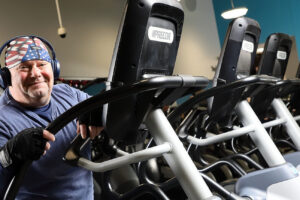When 8-year-old Sean Brill of Aberdeen was a toddler, his sensitivity to noises, crowded spaces, and constricting clothes became more apparent. Anything with buttons, zippers, or tags caused tears, and he was hesitant to try new foods due to their textures. As he grew, he became anxious when weather patterns changed, and his writing was illegible due to low muscle tone. His parents, Stacey and Allen, were becoming increasingly concerned as new struggles emerged.
“Sean started kindergarten after an evaluation determined he was fine academically, but he’d completely melt down every day after school,” says Stacey. “It was overwhelming.”
Stacey then learned that CentraState’s OceanFirst Rehabilitation Center could help. There, they met occupational therapist Skyler Stein, MSOTR/L, who established a special connection with Sean.
“Sean had various atypical behaviors for a boy his age, and they were impacting his success at home, at school, and with extracurricular activities,” says Skyler. “It quickly became clear that he was dealing with sensory processing disorder, or SPD, which is a neurological condition that affects the way sensations are experienced and processed. In Sean’s case, the messages his brain was receiving from his body were very disorganized, resulting in challenges in performing everyday tasks.”
“When Skyler explained this, it was like a light bulb went off,” says Stacey. “Everything we had been dealing with made sense.”
A Plan of Action
Using a play-based approach, Skyler worked with Sean and his family to help him process and cope with the various stimuli that were overloading his sensory system. In particular, they focused on coping strategies, strengthening exercises, seated activities to improve his fine motor skills, and proprioception, which is the perception and awareness of the position and movement of the body. This included techniques for applying soothing pressure to his joints and muscles.
Because family education is critical to success, Skyler provided insight and a toolkit of options that the Brills could integrate into their home life. Sean now has a basket of therapeutic items, like calming toys, to choose from when he feels overstimulated. He participates in muscle-based activities that contribute to the household, like carrying laundry. An exercise ball has enabled him to sit for longer periods of time, and he knows some ways to calm himself at school.
“Sean went from not understanding what his body was experiencing to having a functional, age-appropriate independence level,” says Skyler. “His anxiety has decreased, his self-esteem has improved, and his handwriting is now legible and appropriate.”
Skyler even worked with Sean’s school to facilitate the approval of in-school occupational health and psychology services.
“Therapy is the best thing we could have done, and we’re all in a better place thanks to Skyler,” says Stacey. “She gave us new pathways that changed our lives. We couldn’t have gotten through it without her.”
To learn more about CentraState’s occupational therapy services, visit centrastate.com/rehab or call 866-CENTRA7 (866-236-8727).





